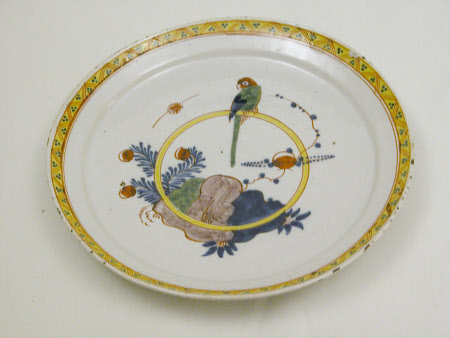Plate
possibly Norfolk House Pottery
Category
Ceramics
Date
1720 - 1730
Materials
Tin-glazed earthenware (Delft faience or 'Delftware')
Measurements
30 mm (Height); 224 mm (Diameter)
Place of origin
Lambeth
Order this imageCollection
Saltram, Devon
NT 871012
Summary
Plate, tin glazed earthenware, possibly made at the Norfolk House Pottery, Lambeth, London, 1720-30; hand painted with a diaper border of yellow, red and blue, within which is painted in blue, green, red and purple a parrot perched on a ring around, painted in yellow around the well, with foliage, flowers and rocks.
Full description
This plate was possibly made at the Norfolk House Pottery, which operated in Church Street, Lambeth, between 1680 and 1779. Unusually, a number of women are recorded as having worked there, as ownership of the Pottery descended through their family. Elizabeth Barston (d. 1704) took over the pottery following the death of her husband. When in 1704 she died 'att ye Pothouse', the business passed to her eldest daughter Anne (d. 1721). Both women were freemen of the Merchant Taylors, a London guild, which allowed them to take on apprentices. The pottery was then inherited by Anne's sister Mary (d. 1734), who had married into another London potting family, the Chilwells. The Norfolk House workshop produced delftware – a type of earthenware with a thick, white glaze made from tin, which was ideal for colourful painting. This included plates and decorative chargers, as well as pots for ointment and medicines, punch bowls, chamber pots and candlesticks.
Provenance
At Saltram by 1951 and accepted by HM Treasury in lieu of full payment of Estate Duty from the Executors of Edmund Robert Parker (1877-1951), 4th Earl of Morley and transferred to NT in 1957
Marks and inscriptions
Unmarked
Makers and roles
possibly Norfolk House Pottery, pottery manufacturer
References
Brian J. Bloice, 1972, Norfolk House, Lambeth: excavations at a delftware kiln site, 1968. Post-Medieval Archaeology 5, Vol 5, pp. 99-159.
